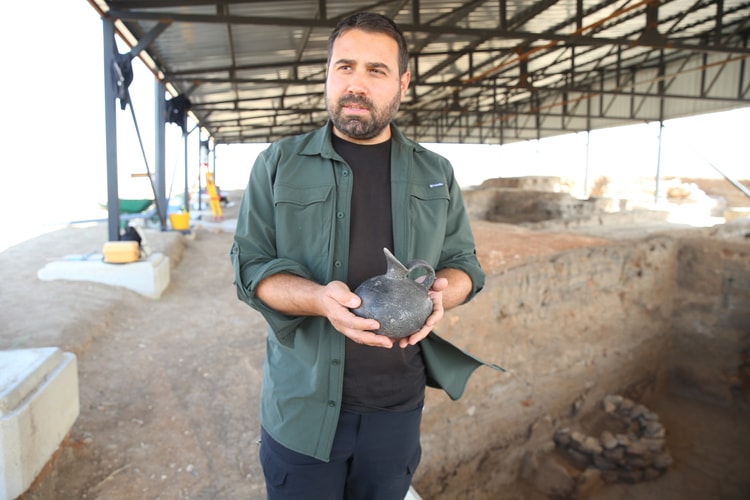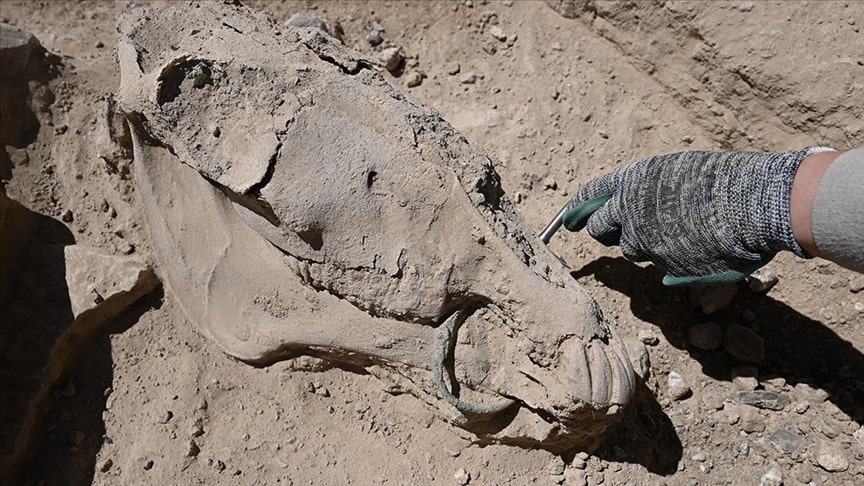During the ongoing excavations at the Küllüoba mound in the Seyitgazi district of Eskişehir, it was discovered that 5,200-year-old structures were preserved by filling them with soil. This discovery raised new questions.
The Küllüoba Mound, which sheds light on the prehistoric and historical periods of Anatolia, has an uninterrupted settlement from the Late Chalcolithic Age to the end of the Early Bronze Age.
The excavations at the mound yielded findings related to the “building burial” cult, which is identified with the Neolithic Period in Southeastern Anatolia. These findings show the interaction of cultures from different regions of Anatolia.

Excavations in Küllüoba are being carried out by a team of 15 people headed by Prof. Dr. Murat Türkteki, a faculty member of Bilecik Şeyh Edebali University Archaeology Department.
In this excavation season, the team revealed that the houses and the items inside them such as hearths, ash pits and silos were completely emptied and cleaned, then buried with a sterile red colored soil (kalish), and even the silo made of mud, which can easily disintegrate, was left under the soil to be protected without being destroyed.
In the area where the sacrificial ritual was performed, the spines of sheep and goats were found placed between the doors and windows filled with stones. In the completely cleaned structure, only one shiny black beak-mouthed jug, which was thrown into the structure in such a way that it broke, may also have been part of this ritual.

The walls are surprisingly preserved up to the roof
Prof. Dr. Murat Türkteki said, “We have determined that all of the structures in this area, at least the back rooms for now, were specifically buried. The red sterile soil found in the surrounding area was completely filled into the structures. In this way, the walls of the structures are preserved up to a height of 2.5-3 meters. Normally in a mound we only encounter the foundations of the buildings, but here we see that the walls of the buildings are preserved almost up to the roof.

Before this process, the doors or ventilation areas were built with stones and then the filling process was carried out. There was obviously a ceremony, a ritual during the filling process. Parts of the sacrificed animals were left inside the blocked areas. Again, one of the vessels used in that ceremony was thrown into the building. Apart from that, nothing was left inside the structure except the interior architectural elements of the building, namely the furnace and silo, and the structure was completely cleaned.”
This method is occasionally found in examples from the Neolithic and Chalcolithic periods in Southeastern Anatolia and Central Anatolia.

“What was their purpose in burying structures?”
“We did not know the existence of such a practice in the Bronze Age until today,” Türkteki said, emphasizing that this is an important development for the archaeological community.
Pointing out that the continuation of this tradition in Anatolia thousands of years later in this region in the west is also thought-provoking, Türkteki said:

“We know that special structures are buried in the Neolithic of Southeastern Anatolia. The situation here shows the existence of this burial ritual. Social memory is of course transmitted for thousands of years, but the purpose here may be different. There are 7 thousand years between us and the Southeastern Anatolian Neolithic. Therefore, there is a huge difference in terms of period and time. Probably the practice is similar but the purpose is different. The structures we have found now are residential, two-room structures.
The purpose may be different. I don’t know if there is a sacred purpose, there is a ceremonial part. This is done with a ceremony, that’s true, but what was the real purpose? It is too early to say anything about that, but we can say this; there are 36 cubic meters of soil in just one structure. It requires a huge workforce, a joint work. There is an organization, but why was this done? Was there a threat? Was there a geographical threat, a climatic threat or a physical threat of another nature? Our work continues in this regard.”

“The building tradition, the practices inside the houses have not changed. We have identified 8 buried structures so far. We can say that they are very close to the surface, arranged on a circular axis. There are rectangular structures. They are positioned vertically and horizontally but continue to be arranged on a circular axis. When we complete this circle, we can say that we are talking about a settlement at least 100 meters in diameter. At this stage, this is actually the earliest settlement of this mound.”
Cover Photo. Yavuz Emrah Sever/AA
















